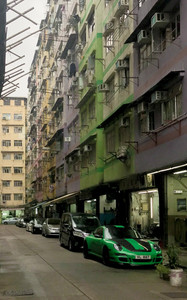To Kwa Wan's Community Dining Room
- Karen Young
- May 21, 2020
- 4 min read
The To Kwa Wan Community Dining Room Project Exhibition is a showcase of the process and outcomes of a 3-year journey through which the To Kwa Wan Community Dining Room (CDR) gradually took its shape in the local neighbourhood. This exhibition was presented by 1a space, a non-profit contemporary visual art organisation in Hong Kong, and hosted at Cattle Depot Artist Village.

Located to the east of the Kowloon peninsula, To Kwa Wan district an old neighbourhood that was once a hub for light industry in the 20 Century. It is one of the last areas that have yet to undergo large-scale urban renewal, but this is quickly changing as a new MTR line is planned to pass through the neighbourhood, and many of the older, shabby-looking buildings are earmarked to be torn down. The need to redevelop is clear, but transforming the area into new high-rises risks jeopardising the existing community network that is very much robust and alive. With this observation in mind, the idea to build a “Community Dining Room” emerged and was brought to life by St James’ Settlement over a period of 3 years.
Through a process of uncovering and furthering nurture a sense of community through observational studies and quantitative data collection, as well as hosting community events, workshops and focus groups, the CDR project aimed to "create a methodology of community and urban planning while everyone in the community can participate cohesively.”[1]
The exhibition showcased a number hand-made furniture by members of the community, painted shutters that depict stories particular to the local store, a number of design proposals for alternative spatial arrangements and design of public spaces made in collaboration with architects and the district councillor, as well as a host of artworks by local artists that respond and reflect on the processes behind these collective imaginations and community-driven designs. These are the artefacts and evidence of the consolidation and augmentation of a local sense of belonging.
At the exhibition, I was most impressed by the To Kwa Wan community's openness to speak of local concerns about relating to public space about the lack of thereof, the lack of suitable facilities (e.g. benches for the elderly to rest in between their grocery visits), the uncomfortable environment (especially given Hong Kong's hot and humid summers), problems associated with anti-social activities occupying such 'public spaces' in the evening, but also of their aspirations, of a community that is unique and vibrant, a neighbourhood with child and elderly-friendly public spaces. All of these were captured in effortless conversations that were on display at the exhibition.
Speaking to Ah Him, a member of the three-strong curatorial team (and very much the team that brought this project to fruition), I learnt more about the challenges they faced and overcame in order to arrive at such a collaborative atmosphere amongst members of the neighbourhood. Him highlighted the importance of earning the community's trust and building a sense of togetherness in the early stages of the project. This was their key to understanding what the To Kwa Wan residents thought and felt about their environment, and subsequently, empowering the community to not only voice their ideas, but also partake in the realisation of these ideas. Him further elaborated that in the process of organising and delivering community activities, it was inevitable that participants would bring forth contradictory and conflicting opinions. At one instance, there were participants who were strongly for and against smoking in open public spaces present at the same meeting, and each argued fervently for their case. The CDR team's role was then to facilitate productive discussion. Him remarked that participants' have become more inclusive, open-minded and even willing to experiment, and this then found expression in the delivery of the Common Dining Room. The key takeaway from this conversation was when Him brought up the importance of listening as they were organising, delivering and furthering the Common Dining Room project. This applies not only to the community participating in the project, but also, to professionals – such as architects – that collaborate in such initiatives.

Participatory design (or, participatory architecture, or even more broadly, social architecture?), a design methodology in which the stakeholders are actively engaged, alongside the designer, in the design process, is "hands-on democracy in action" as the editors of Design of Democracy: Techniques for Collective Creativity argue. However, as much as this may sound like a promising approach to generate designs that actually respond to the stakeholder's needs, concerns, and aspirations, many have also questioned the designer's relevance and agency in such a process, especially when successful participatory design projects are stacked up against many other projects that are less satisfactory. With respect to this, what I have understood quite tangibly from visiting the Common Dining Room exhibition, was how one of the architect's (designer's) function in such an ecosystem is to act as a translator of the community's imaginations (from the bottom-up, so to speak), and relevant regulations and codes that are in place (the top down), and creatively craft and articulate a design that can communicate both ways, and be understood both ways.
All in all, it encouraging to see the enthusiastic involvement of To Kwa Wan residents in projects such as Common Dining Room. What I am keen to learn more about is how - if at all - this spirit of collective making, designing, and ultimately bettering the local area that was kickstarted by this project becomes embedded in the way To Kwa Wan develops as it continues to cope with anticipated changes to the physical and social fabric of the neighbourhood.
[1] 1a Space, ‘Participatory Public Lab: To Kwa Wan Community Dining Room Project Exhibition’.
More about the exhibition:

























Comments